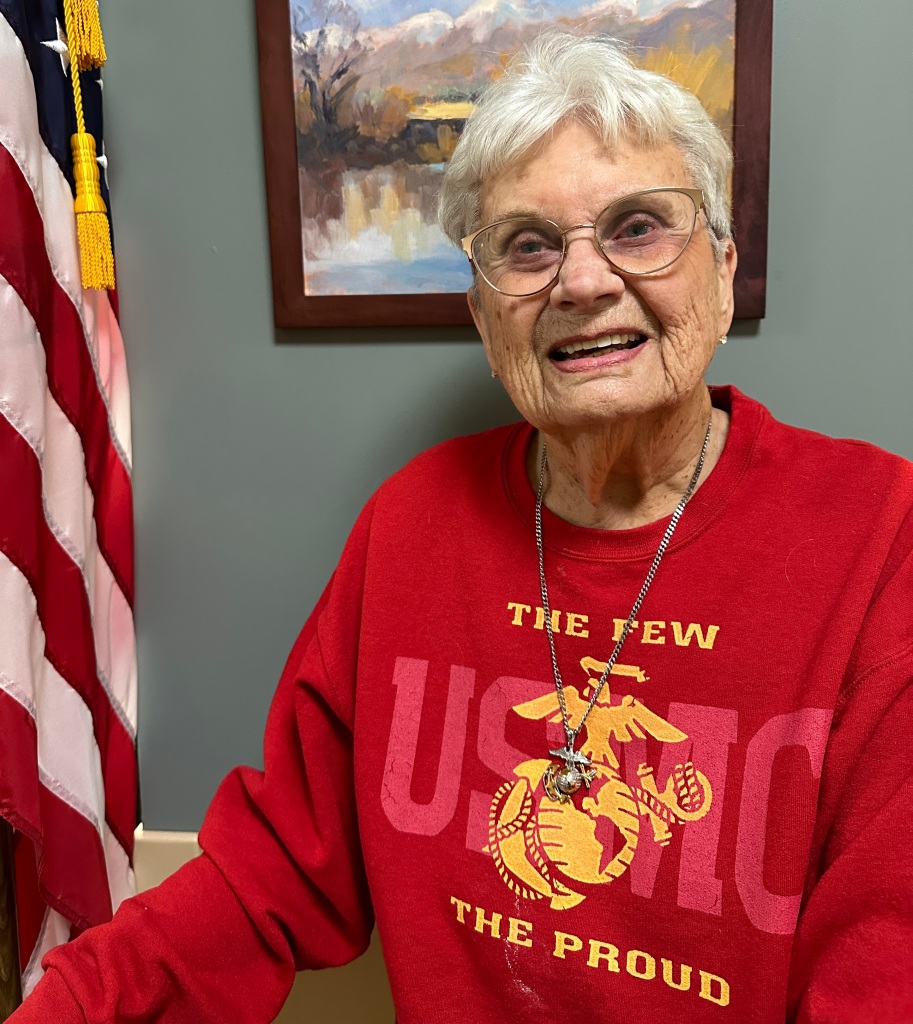As the Korean War raged in 1951, Lois Sweeney decided to become one of “The few. The proud. The Marines.”
She enlisted and soon found herself at Parris Island, South Carolina — one of the 138,000 recruits who trained there throughout the war.
“I was in the swamp,” the 92-year-old resident of the Veterans Home of California-Redding said. “It was hot and humid. It was miserable. We heard a lot of bad language from the instructors. They weren’t too easy on us. But I got through boot camp.”
All to prepare her for … three years of shuffling papers at a desk there and later at other Marine installations.
Among other things, Women’s Military History Week serves to remind and educate us about the evolution of women in the military.
Through World War II, most women who served did so primarily on temporary assignments at home. They worked in clerical jobs, transportation, aviation, and a wide variety of other jobs to aid the war effort and to free up men for combat. Those who deployed near the front lines usually were nurses, including 16 Army nurses who were killed and 68 more who became POWs in the Philippines. More than 2,000 women were decorated for bravery in combat zones.
Despite the desire to continue serving, the vast majority of women were discharged six months after Japan surrendered to end the war. President Truman changed that when he signed the Women’s Armed Services Integration Act of 1948, which allowed women to serve as regular members of the military and receive veterans’ status and benefits. However, it didn’t open a floodgate for deployments overseas. That didn’t begin until after the Korean War.
“They started doing that about the time I got out, sending women (Marines) to Germany and Hawaii,” Sweeney said. “By that time, I had other things on my mind.”

She returned to the West Coast, working at El Toro Marine Air Station near Irvine and Camp Pendleton near San Diego before leaving the Marines in 1954 to marry a Marine fighter pilot who went on to become an FBI agent. That took them back east to Quantico, Virginia, where he went through the FBI academy. The marriage ended in divorce.
By 1969, Sweeney had remarried, moved to Redding, and decided to become a pilot herself.
“It was something I’d wanted to do since I was a little girl,” she said. “I met people there who had a plane and they started taking me with them to Puerto Vallarta.”
She began taking lessons, learning to fly a Cessna 150 and, after getting her pilot’s license, bought a larger, more powerful Cessna 172.
While Sweeney never deployed as a Marine, she and friends — among them Pam Vander Linden, “Peanuts” cartoonist Charles Schultz’s mother-in-law — “deployed” a civilian excursion on their own in 1980. They were part of a group of women pilots who flew south along the West Coast, touring Central American and South American countries all the way to Brazil.
“We had a wonderful time,” Sweeney said. “We went to Cuzco and Machu Picchu and saw the ruins.”
She participated in that lengthy trip while on vacation from her day job at the Shasta County Sheriff’s department, where she’d worked first as dispatcher, then as a deputy at the jail, a court bailiff and part-time duty with the boat patrol on Lake Shasta. Sweeney retired in 1987 and moved into the Veterans Home of California-Redding a year ago.
In 2013 — six decades after she left the Marines — the Pentagon lifted the ban on women serving in front-line combat positions. The elimination of that ban means that for today’s female service members, sloshing through boot camp swamps no longer has to dead-end at a desk assignment.
That era of women’s military service is, well, history.
The Veterans Homes of California system of care offers affordable long-term care to older and disabled veterans as well as their eligible spouses and domestic partners. With eight facilities across the state, the services offered range from assisted living programs with minimal support to 24-hour skilled nursing care for veterans with significant clinical needs including memory care.
CalVet staff are uniquely capable of serving the needs of our veterans and provide an environment that honors their service to the country. The Veterans Homes are nationally recognized for the premier care and services they provide to California’s veterans. For more information on the Homes visit www.calvet.ca.gov/calvet-programs/veteran-homes.
Would you like the opportunity to serve veterans in your work? Join the CalVet team! We are dedicated to ensuring that veterans from every era, along with their families, receive the state and federal benefits and services they have earned and deserve due to their selfless and honorable military service. At CalVet, we prioritize serving veterans and their families with dignity, compassion, and a commitment to helping them achieve the highest quality of life. See our current career opportunities at www.calcareers.ca.gov/CalVet.
